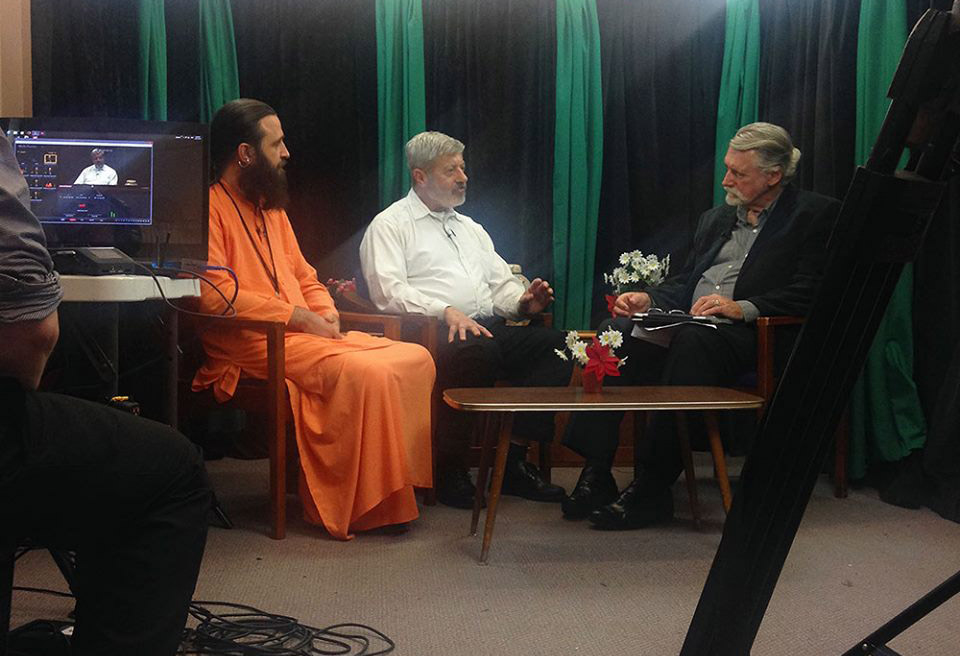Summary of discussion on Vijnana-bhairava-tantra made by Guru Yogi Matsyendranath and Rev. John Dupuche
Vijñānabhairava-tantra 40
Technique: focussing on the emptiness at the beginning and end of a sound
yasya kasyāpi varṇasya pūrvāntāv anubhāvayet |
śūnyayā śūnyabhūto ‘sau śūnyākāraḥ pumān bhavet || 40 ||
“He should focus on the beginning and end of any sound. By becoming ‘void’ due to the power of the void, the man takes on the form of the void.”
Any (kasyāpi) sound or phoneme (varṇa) arises out of non-sound, out of the emptiness (śūnya) of sound, and ends in the reabsorption of sound. The technique is to experience (anubhāvayet) the moment when the varṇa arises and the moment when it is absorbed, its beginning and end (pūrvāntāv).
The beginning and the end of a sound are moments of particular power. They manifest the relationship of Śiva and Śakti. If Śiva is I am (aham), then his self-awareness, ‘I am’, is his Śakti. These stand in the relationship of light (prakāśa) and auto-illumination (vimarśa). They are in eternal union, one never without the other, inseparable.
This self-awareness, ‘I am’, is the supreme word (paravāc or vāc), and this primordial ‘word’ is the origin of all words; this essential ‘mantra’ is the basis of all mantras and permeates them all.
Thus in the act of recitation there is a double aspect, the absence of sound and the spontaneous arising of sound and its equally natural disappearance. It is spontaneous because Śakti is freedom itself (svātantrya). Beginners start the sound with an act of the will but, when recitation becomes perfect, the sound arises spontaneously from the depths of their being. This spontaneity means that the sound becomes natural (sahaja) to them. It arises from the void for Śiva is emptiness, and return to the void.
This ‘emptiness’ is open, welcoming, without limits, without barrier or duplicity.
Disciples wish to hear the words of the guru, which spring spontaneously and intelligently, wisely and energetically from him. The more his words spring from ‘emptiness’ the more energetic and powerful they will be. The disciples listen to the words but also perceive the immense void and restfulness from which the words come and to which they lead. The guru’s words enter them but his silence enters them also and they become silent in his silence. Silence inspires silence.
The word śūnya (empty) occurs three times in the one line.
One becomes ‘empty’ (śūnyabhūto) ultimately not by means of the will but by the sheer power of emptiness (śūnyayā). Nothing can control emptiness. It is something to be experienced (anubhāvayet) and in this sense is happens spontaneously. Emptiness is its own source. No object or means can produce emptiness. Emptiness occurs by means of emptiness. The result is that a mere man (puman) becomes śūnyākārah. The word akārah means‘sound’ or ‘letter’; the word ākāra means ‘shape’ or ‘form’. The man therefore becomes Śiva/Śakti, both emptiness and sound (śūnya-akārah). Or having become empty, he is the image (ākāra) or manifestation of Śiva who is emptiness (śūnya). These two meanings impact on each other and explain to the richness of the result.
This emptiness moves the heart and mind of the reciter so that he becomes perfectly still and void of all ambition, of all desires and attachments, free at last. The practitioner becomes ‘empty’, and the sound resounds in him without hindrance.
The beginner will need to recite the sound over and over, many lakhs of times, but the more proficient he becomes, the less need there is to recite it. Indeed, ultimately there is only one utterance of the one sound. The auto-illumination of Śiva occurs once and forever, perfectly. The yogī will eventually reach the state when, in saying the sound once, he will have said it perfectly and need not repeat it. But that is at the end of a long path.








